Last Updated on November 28, 2025
Business budgeting
When running a business, be it a new or an evolved enterprise, one of the most crucial areas to tackle and take charge of is bookkeeping, or, to be more precise: business budgeting.
Business budgets help you take stock of how much money you have, how much you need, and how much you’ve spent.
It is essential for your business plan, cash flow, forecast, goals, priorities, and performance evaluation.
In this article, you will learn why a business budget is crucial, how to create one, its components, and some of the best software that can assist you through all the processes
What is budgeting in business?
Business budgeting involves creating a financial plan for a company.
The budgeting process includes financial goal setting, liability estimation, revenue and expense forecast, and resource allocation to achieve short-term or long-term goals within a specified time (generally a fiscal year).
Budgets span different timeframes, such as weekly, monthly, quarterly, or annually. In a business budget, companies project various factors that affect a business, including operating expenses, sales revenue, additional expenditures, and cash flow.
Consider the budget a roadmap for financial decisions, resource allocation, and performance monitoring.
Also, Read: Budgeting and Forecasting: Key Differences
Why is budgeting important to a business?
Budgeting is a critical aspect for businesses to tackle as it helps provide a detailed plan to manage business finances better, leading to better financial outcomes.
Let’s take a look at five reasons why budgeting is important to a business:
1. Ensures resource availability
Budgeting provides a framework for financial resource allocation, which helps ensure resource availability. Companies estimate the amount of money they need to allocate to different functions, departments, or activities through goal-setting and revenue projections.
As a result, it helps prevent overspending and makes sure there’s enough money available to cover essential costs such as salaries, leases, office supplies, or utilities.
2. Prevents overspending
By setting realistic financial goals and projecting business expenses, you can avoid overspending and ensure you invest in resources to control costs. Budgeting helps a business track its financial performance and compare it with projections. This way, a company can identify gaps or inefficiencies and adjust its spending accordingly.
3. Improves decision-making
Business budgeting enhances accountability, supports strategic alignment, and improves problem-solving. This helps companies identify deviations and discrepancies, and resolve potential risks efficiently to make better business decisions.
4. Provides clarity and direction
Business budgets help companies align their activities with their vision and goals. It helps them define their financial objectives and map out steps to achieve them. In turn, businesses can prioritize projects and initiatives based on expected ROI and value.
5. Improves internal collaboration and communication
Budgets help businesses communicate their financial goals and expectations to employees, investors, customers, and vendors. It also helps them seamlessly collaborate with different departments and teams to coordinate their budgets to ensure consistency.
Also, Read: What is Financial Modelling?
Types of budgeting methods for business
Here are the various types of budgets companies can follow, depending on their requirements and preferences:
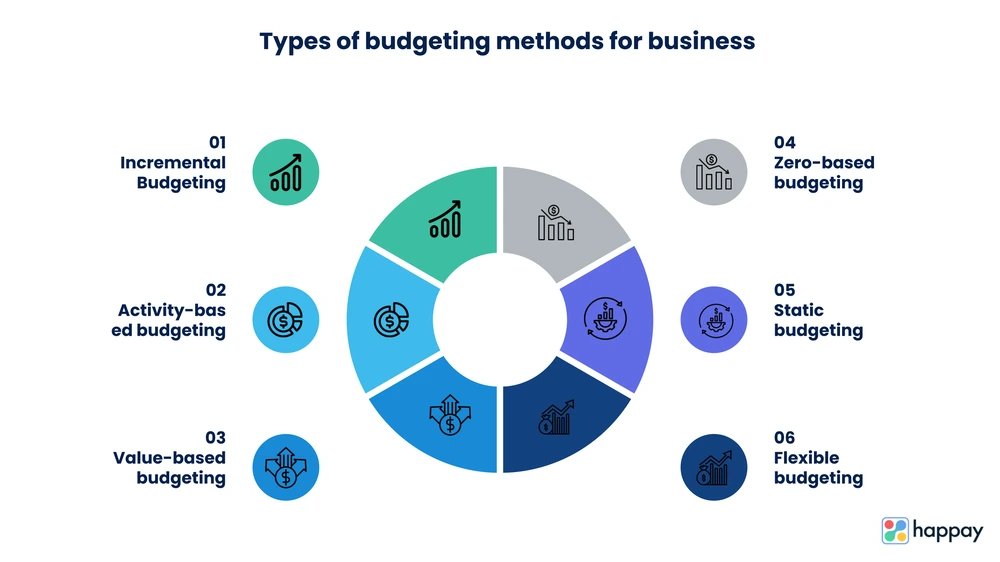
1. Incremental budgeting
Incremental budgeting takes the previous year’s actual figures and either adds or subtracts a percentage to obtain the current budget.
For example, if a company paid $400,000 in salaries last year and plans to increase wages by 10% and hire six new employees with a salary of $25,000 each, the current year’s budget will be:
New budget = (Old budget x 1.1) + (New hires x salary)
New budget = ($400,000 x 1.1) + (6 x $25,000)
New budget = $490,000
2. Activity-based budgeting
This budgeting type determines the number of inputs required to support the targets set by the company. It is more realistic and accurate, but calculating it may be time-consuming and complex.
For example, if a company sets a sales target of $150million and estimates that it needs to spend $20 million on marketing, $30 million on development, $10 million on admin activities, and $2 million on R&D to achieve it, the formula for the budget is:
New budget = Total sum of inputs required for output
New budget = $20 million + $30 million + $10 million + $2 million
New budget = $62 million
3. Value-based budgeting
This next type takes each item’s value in the budget for customers, employees, and other stakeholders.
It aims to remove unnecessary expenditures, but it can be subjective and difficult to measure.
For example, if a company wants to launch a new product and needs to allocate funds for its development, marketing, promotion, and service, it would ask questions like:
- Why is it included in the budget?
- Does it create value for all the stakeholders?
- Does the value outweigh its cost?
- If not, is there another reason why the cost is justified?
The company can decide how much to spend on each item based on these answers.
Recommended Read: What is capital expenditure?
4. Zero-based budgeting
Zero-based budgeting assumes that the overall budgets are zero and should be built from scratch. It is more efficient and accountable.
For example, if a company wants to reduce its costs and improve its performance, it would ask each department to justify every expense and activity they plan to undertake next year.
The company will then rank the requests according to their priority and distribute the funds accordingly.
The formula for this year’s budget will be
New budget = Sum of justified expenses
New budget = Expense 1 + Expense 2 + … + Expense n
5. Static budgeting
Static budgeting incorporates forecasted input and output values that are decided before the period begins. A static budget is a projection of revenue and expenses over a specific period and remains unaltered even with an increase or decrease in sales and production volumes.
This type applies more to fixed costs, such as rent or salaries. Static budgeting serves as a guide or map for the overall direction of the company and a mechanism to prevent overspending.
For example, say a company has a sales commission budget of $50,000. This means the company expects to pay $50,000 in commissions to its sales staff regardless of how much sales they generate. If the actual sales are higher or lower than expected, the static budget will not change.
6. Flexible budgeting
This budgeting type fits into company activities or profit margins. It calculates different levels of spending for variable costs, depending on revenue changes over some time.
A flexible budget fluctuates with changes in sales and production volumes and applies to variable costs, such as raw materials or commissions.
Flexible budgeting helps provide a company’s accountants and other financial staff members with a more realistic and accurate budget overview. It also helps evaluate the efficiency and effectiveness of the company.
For example, say a business follows a flexible budget. It has a variable cost of $10 per output and a fixed cost of $20,000.
This means the company’s total cost depends on how many units it produces and sells. The flexible budget changes if the output is higher or lower than expected.
Suggested Read: What is Financial Reporting?
Ideal components in a business budget
A few things you need to keep in mind before budget planning for your company are fund allocation details and expectations, among many other factors.

1. Business and market description
This component needs to provide an overview of the products or services your company offers, target customers, competitors, and USP. Here, you must explain how your company fits into existing market trends.
2. How your budget supports company goals
Explain how your budget is in line with your company’s mission, vision, values, and objectives. It needs to align with your strategic plan and show how your budget will help in achieving your goals, along with any risks or challenges you foresee.
3. Line-item details for funds allocation
You need to list all your income sources and expenses, including revenue from sales volume, cost of goods sold, operating expenses, interest, and asset depreciation. You should show how much you plan to spend on each item and how it applies to your revenue projection.
4. Performance expectations
Under this component, highlight ways to evaluate your budget strength and efficiency and how often you will review and update the budget based on results or changing situations.
5. Appendices
This component should provide any additional information or documents that support your budget, such as financial statements, cash flow forecasts, financial plans, and market research.
6. Executive summary
This component summarizes the main points of your budget concisely and clearly. It highlights your key assumptions, goals, challenges, and recommendations for your business.
Quick Read: Embedded Finance: Examples, Benefits and Opportunities
How to create a business budget?
While there is no one-size-fits-all approach to creating a business budget from scratch, here are a few steps to help you get started:
- Examine your revenue sources and estimate your monthly income. Use historical data, industry averages, or growth projections to forecast revenue.
- Subtract your fixed costs from your revenue. Fixed costs are expenses that do not change regardless of your sales or activity level, such as rent, salaries, and insurance.
- Determine your variable expenses. Variable expenses fluctuate depending on your sales or activity level, such as marketing, supplies, or utilities.
- Analyze all your business costs. Categorize your business costs into essential and discretionary expenses. Essential expenses are necessary for your business operations, while discretionary expenses are optional and reducible.
- Set aside an emergency fund. Do this for unexpected costs, one-time expenses, or emergencies. A contingency fund can help cover unforeseen expenses or revenue shortfalls without compromising your budget goals.
- Create your profit and loss statement. A profit and loss statement summarizes your revenue, expenses, and profit for a period. It can help you track your financial performance and identify areas for improvement.
- Outline your business budget. This is a plan for how you will allocate your resources in the future based on your goals and expectations. It can help you make strategic decisions and measure your progress.
- Assess your budget throughout the year. A budget is not a static document, but a dynamic tool that should reflect your changing business needs and realities. You should review your budget regularly and compare it with your actual results to see if you are on track or need to make changes.
Also, Read: 11 Best Online Business Payment Solutions
Business budgeting tips
Here are a few tips you can follow before creating a business budget:
- Understand what a budget is and why you need it. A budget is a guide to help you make better spending decisions, plan for the future, and allocate funds efficiently. It can also help you identify areas for improvement and track your financial performance.
- Know your organization and its risks. Businesses have different budgeting needs depending on their industry, size, seasonality, regulations, and goals. You should be aware of the factors that affect your income and expenses and accordingly adjust your budget.
- Make a spreadsheet or use a software tool. You can create a budget using Excel or any other spreadsheet program. You can also use a software tool that can automate some tasks and provide you with templates and reports.
- Gather your historical financial data and project your income and expenses. You should base your budget on past performance and set realistic expectations for the future. You should include all your sources of revenue and expense categories, as well as any contingencies or emergencies.
- Review and update your budget regularly. Review and update your budget at least monthly or quarterly, or whenever there are significant changes in your business. You should also compare your actual results with your budgeted numbers and analyze discrepancies.
- Shop around for services and suppliers and look for ways to cut costs. You should always look for opportunities to save money and increase your profit margin. You can do this by improving efficiency, or increasing sales.
Also, Read: 20 Business Expense Categories List
What is business budgeting software?
Business budgeting software helps companies design, manage, monitor, and alter its budget.
It can help you track your income and expenses, create forecasts and scenarios, generate reports and dashboards, and integrate with other tools like accounting software or ERP systems.
Some of the factors to consider when choosing budgeting software are:
- The size and complexity of your business and its budgeting needs
- The cost and ease of use of the software
- The features and functionality of the software
- The integration and compatibility of the software with other systems
- The security and reliability of the software
- Customer support and updates of the software
Best business budgeting software
Let’s take a look at the top 5 best business budgeting software in the market:
1. Vena
Vena is a budget planning software that uses Excel as its interface, and integrates with Microsoft 365 and Power BI. Vena allows you to create budgets, forecasts, reports, dashboards, and scenarios using your existing Excel templates and data sources.
Vena also offers solutions for financial consolidation and close, account reconciliation, incentive compensation management, tax provisioning, and more.
Also, Read: 11 Best Billing Software in India
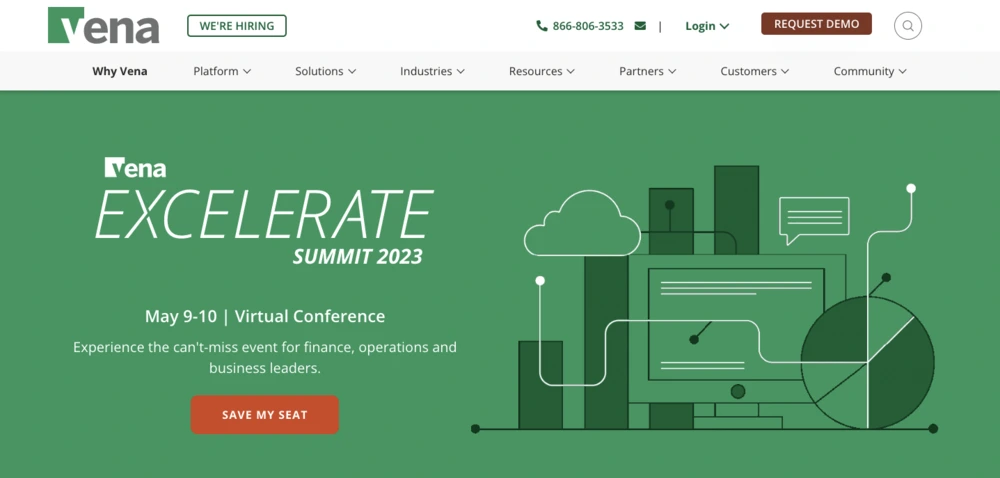
2. Planful
Planful is a cloud-based budgeting software that provides solutions for financial planning and analysis (FP&A), financial close and consolidation, and reporting and visual analytics.
Planful uses an Excel interface and integrates with various data sources and systems. With Planful, you can streamline and automate your budgeting, forecasting, and scenario modeling processes and align them with your strategic goals.
Also, Read: 10 Best Expense Management Software
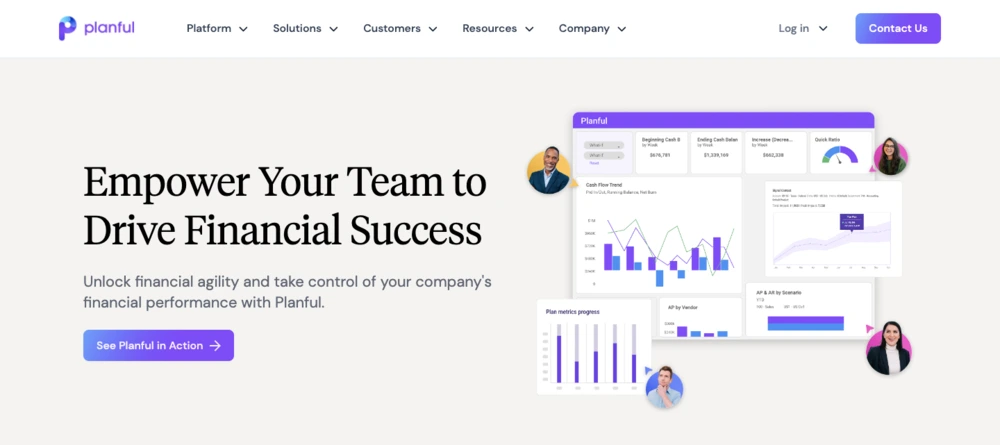
3. Prophix
Prophix empowers mid-market companies to achieve their goals by providing an integrated, cloud-based platform. The platform delivers planning, budgeting, reporting, forecasting, and consolidation solutions that help finance leaders improve profitability, minimize risk and focus on uncovering more business opportunities.
Quick Read: 9 Best Accounting Software for Small Business
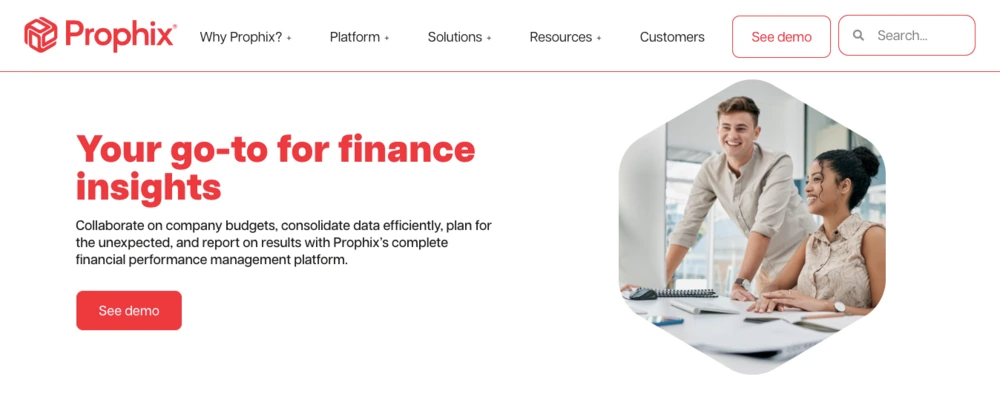
4. Causal
With Causal, you can build financial models and share them with interactive, visual dashboards that everyone will understand. Causal makes it easy to understand the models and is quick to build, so you can save time and effort.
The solution simplifies advanced modeling techniques like scenario analysis, sensitivity analysis, and uncertainty inputs. You can also integrate all your most important data sources, from spreadsheet software like Sheets or Excel to accounting platforms like Xero and Quickbooks.
Also, Read: Top 6 Enterprise Payment Software
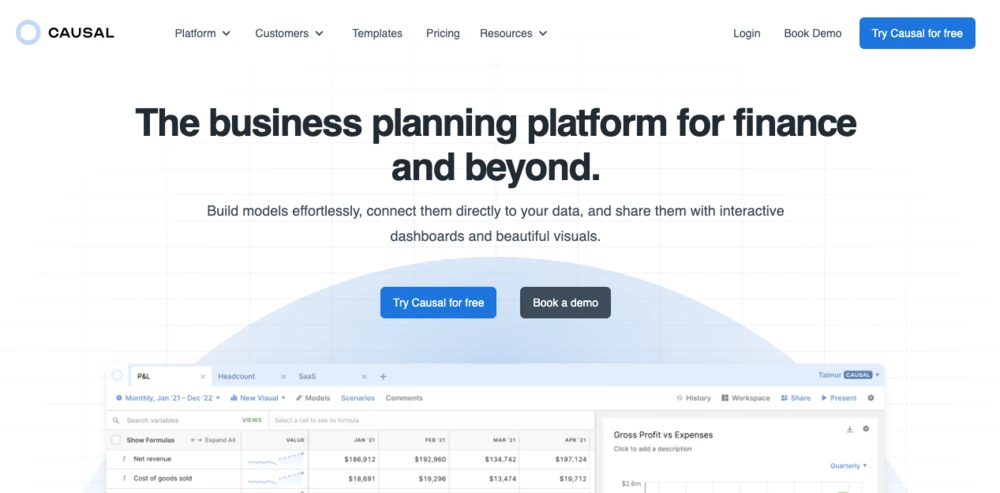
5. Mosaic Tech
Mosaic Tech integrates data from various financial systems, automates analytics, and connects teams to help them focus better. Its features include analytics, planning, and integrations, which sync data from ERP, CRM, HRIS, and billing systems. Mosaic Tech helps finance teams break reactive cycles and see the bigger picture of their business performance.
Also, Read: 6 Best Cash Flow Management Software
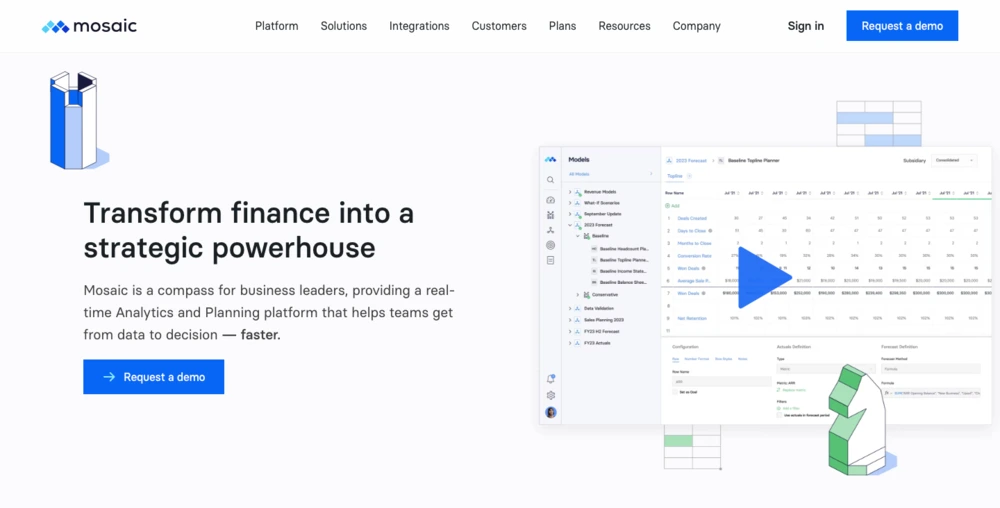
How Happay helps with business budgeting
Happay is a business expense management solution that helps you streamline and automate your entire expense workflow, from capturing receipts to approving and reimbursing expenses. They also offer integrated solutions for corporate travel and payments management.
Happay’s consistently top-rated solution helps with business budgeting in the following ways:
- Reduce reliance on cash and paper and save more time and money on expense management
- Integrate Happay with popular accounting software and ERP systems to simplify your reconciliation and compliance process
- Improve visibility and control over business spending and optimize budget performance
- Set limits and policies on employee prepaid or credit card spending. This ensures you enforce the budget instead of creating one from the ground-up
- Enforce budgets, set limits and policies on employee card spends through prepaid or credit cards and set limits and policies on their spending
- Track and monitor expenses in real-time with spend visibility and get detailed reports and analytics on spending patterns
Businesses of all sizes use Happay, with over 7000 customers globally.
Happay aims to make expense management cashless, paperless, and mobile by simplifying the entire expense workflow.
You can contact the team for a demo and learn more about their pricing.
Conclusion
Business budgeting is crucial for any company that wants to achieve its goals and optimize its resources. It helps plan and monitor income and expenses, allocate funds to strategic initiatives, and evaluate performance and efficiency.
Choosing the right budgeting method, following best practices, and using the right software can help improve financial management and decision-making.
FAQs
The 3 main types of budgeting are:
a) Incremental: Which involves making changes to the previous year’s budgets by making small increments
b) Zero-based: This method requires every expense to be justified from scratch, without reliance on previous methods
c) Flexible budgeting: Flexible budgeting adjusts for changes in activity levels that allow for more accurate forecasting and cost control
One example of budgeting includes creating a monthly budget plan that outlines expected revenues and expenses, including salaries, rent, utilities, and inventory costs, to ensure that a company doesn’t overstep its means and achieves its financial goals.
A business budget’s goal is to plan and control the financial resources of a company to achieve its financial objectives such as, increasing profits, reducing costs, improving cash flow, and optimizing resource allocation.
The three steps to construct a business budget are:
a) Establishing financial goals and objectives
b) Estimating revenues and expenses
c) Monitoring and adjusting the budget over time to ensure it’s on track
A business follows these steps to write a budget:
a) Gather financial data and historical records
b) Determine financial goals and objectives
c) Estimate revenues and expenses
d) Allocate resources and prioritize spending
e) Create a plan and get feedback from stakeholders
f) Monitor it and adjust as needed
A budget period is a specific time frame such as a month, quarter, or year during which the budget creation happens. This is then used to plan and control the financial resources of the company.










Discussion about this post